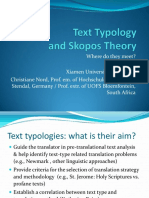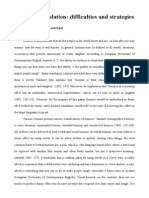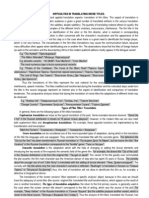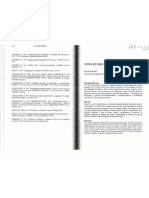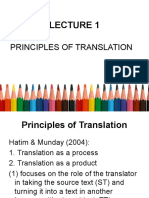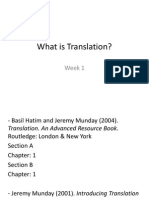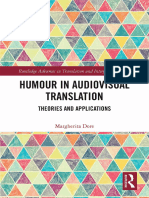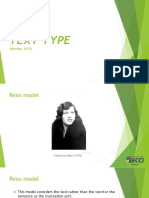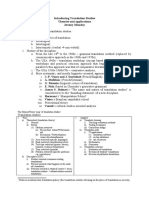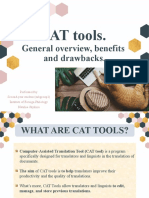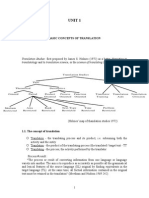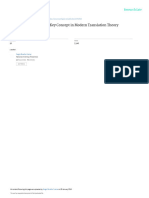100% (1) 100% found this document useful (1 vote) 1K views 6 pages Reiss Text Types
Katharina Reiss's work on text types has significantly influenced translation theory by linking it to text linguistics and communication studies. She classifies texts into four types—informative, expressive, operative, and audio-medial—each requiring different translation approaches based on their primary communicative function. Reiss emphasizes that successful translation must maintain the original text's intent, whether it is to inform, evoke emotion, or induce action, while also considering the specific conventions of various text varieties.
AI-enhanced title and description
Copyright
© © All Rights Reserved
We take content rights seriously. If you suspect this is your content,
claim it here .
Available Formats
Download as PDF or read online on Scribd
Go to previous items Go to next items
Save Reiss Text types For Later 11. Text types, translation types and translation assessment
Katharina Reiss
Reiss’ work on text types has been a major influence in contemporary trans-
lation theory. Her book on the subject dates from 1976; the present article sum-
marizing some of her ideas appeared in 1977. Her approach relates translation
closely to text linguistics and communication studies.
With respect to the classification of text types, Reiss starts by sticking 0 the
traditional three based on Biihler’s functions of the linguistic sign, but adds an
audio-medial type to cover the increasing use of language (and translation)
which is linked simultaneously to other media. The special requirements of this
text type can be very restricting indeed - such as the number of letters permitted
on the TV-screen for a given subtitle - and it makes sense to consider this kind of
translation separately.
In her book (1976) Reiss illustrates the relation between the traditional three
text types and various text varieties in the form of diagrams. The main points of
these can perhaps be summarized as follows. The diagram shows how examples
of different text varieties can be approximately placed with respect to the three
functions: no text variety represents only one function; each has its own characte
ristic mixture.
INFORMATIVE
‘Teference book
report
lecture
operating instructions
tourist brochure
biography sermon
official speech
play electoral speech
poem satire advertisement
EXPRESSIVE OPERATIVE
These placings are of course only rough indications
The primary function of a translated text clearly affects how the translator
will operate, Reiss suggests (e.g. 1976: 20ff) that primarily informative texts�should be translated in plain prose, with expansions and explanations oo
necessary. A primarily expressive text needs an “identifying” translation method,
where the translator aims at empathy wih the original writer Primarily persis
texts require an “adaptive” ranslation, determined by the way the intended TT
receives are assumed to react othe text. Auio-medial txts shouldbe translate
ina “suppletory” way, supplementing what is expressed by the pictures, msi ¢
For Reiss’s later work, see e.g. Reiss and Vermeer (1984, 1986). Translation
assessment is taken up further in chapter 14, below.
©. The phenomenon of linguistic translation is probably not much younger
than mankind itself, although of course this cannot be established wit ay
certainty: mankind's collective memory, surviving in mythology, mentions 1
‘Tower of Babel and its disastous consequences. We must be content 0 state
that there has always been translation; there hes always een eriicism of
translations; and there have always been clever heads to ponder the problems
of translating, while streams of ink have flowed as both homogeneous and
heterogeneous views on this theme have been passed down to future gene
ne his state of affairs might well lead one resignedly tothe following oe
clusion: enough of the gruesome game = it's all been said already, for in the
old days they were certainly no more stupid than we are today. How can o}
find anything new worth saying that has not already been seid ages ago?
‘And yet = the old, etemally young problem of translation exerts an enot
‘mous fascination on each new generation, This remains tue today, when the
phenomenon of translation has even more relevance than earlier: people o
the most varied tongues have surely never borne witness so clearly to, the
urgent need of permanent intelingual communication on all levels and in a
spheres of life. Hence too the present-day trend to bring all kinds of ansla
tion material into translation theory research not only so-aled “ltertry
texts", but also "pragmatic texts, conceming which even, Schieiemnacher
(4813/1963: 42) maintained that translating them was ‘almost purely
mechanical business which anyone can do who has a reasonable knowledge of
we two languages’ :
= Ter perheps nothing absolutely new can be said, it may well cy be
possible to discover hitherto unnoticed cross-relationships, or clarify hitherto
overlooked associations, This would contribute towards increasingly removing
the translation activity from the sphere of pure intuition, of subjective criteria;
it would thus serve to systematize translation problems, make translation itself
teachable to some extent, and also objectivize the assessment of translations.
This aim fits with the development of modern linguistics, which aspires to
Precise verifiable or falsifiable results on the model of the natural sciences,
Earlier, the problems of translation were primarily discussed, with very diffe-
Tent motives, by language philosophers, poets and writers, and also practical
translators; in the second half of the present century, however - especially
owing to the ambitious aim of constructing a “translation machine" (cf. Wilss
1973) - on the one hand linguistics has turned its attention towards translation,
and on the other translation research itself has begun to make use of strictly
linguistic methods. The significance and necessity of this cooperation between
linguistics and translation research is well illustrated by a formulation of
George Mounin (1967: 61): "Translation is never a uniquely and exclusively
linguistic operation, but it is first of all and always a linguistic operation. "Of
course, like all such apodictic sentences, this statement needs to be qualified:
it all depends on how one interprets the word "linguistic". Without going any
further into this problem area, I would just like to point out here that the
Statement is the more readily accepted the more modern linguistics extends its
goals beyond the sentence boundary; in other words, the more it is prepared
to adopt a sextlinguistic approach and see genuine translation as an act of
verbal textual communication. (This amounts to a semiotic definition of trans-
lation. Semiotically, the sign systems of natural languages are only one means
whereby texts can be realized; other possible sign systems include mime,
gesture, colour, pictures, etc.)
1. For if we ask why texts are normally translated, the answer must - ina
general sense - be: a translation is a communicative service, and normally a
service for a target language receiver or receivers. The normal function of a
tanslation service is to include a new (target language) readership in a com-
municative act which was originally restricted to the source language com-
‘munity. This holds even for texts which in their source language form might
not be thought to be truly communicative, such as diaries, personal memos,
Rotes, etc. If such texts are sanslated, there must nevertheless be some
(secondary) will to communicate. Communication theory will thus be prima-
rily concemed to establish some basic systematic order in the enormous multi-
plicity of actual translation material. In order to set up a text typology that
would be relevant to translation, it thus makes sense to begin with the basic
Communicative situations in which texts fulfil quite specific and fundamentally
distinct communicative functions�Since natural languages form the basic material of verbal texts, we first
take a look at language itself.
Language has long been classified intuitively, according to the pre-
dominant mode of expression, as functional language, literary language or
address. In the 1930's the psychologist Karl Bilhler (1934/1965) distinguished
three functions of a linguistic sign: informative (Darstellung), expressive
(Ausdruck) and vocative (Appell). The semanticist Ulrich Stiehler (1970: 32)
associated these three language functions with the realization of three types.of
human cognition: thinking (or perceiving), feeling and willing. The Tubingen
linguist Eugenio Coseriu (1970: 27) sees the three functions in terms of their
relative dominance in linguistic utterances, and thus distinguishes three Ian-
guage forms: "a descriptive, declarative or informative language form, the
main object of which is providing information about a given topic; an expres-
sive or affective or emotive form, mainly expressing the speaker's state of
mind or feeling; and a vocative or imperative form which primarily seeks to
bring out certain behaviour in the hearer.” This classification thus basically re-
lates the main objective of a language form to one of the three main elements
in the communicative process: sender (= speaker, writer); receiver (= hear-
cr, reader); and topic (= information).
‘This tripartite aspect of language itself suggests a similar tripartite divi-
sion of basic verbal communicative situations; moreover, the many verbal
constituents of the secondary system of language (ie. its written form) can
also be seen in terms of three rough types.
According to their communicative intention, verbal texts thus display
three possible communicative functions, correlating with the dominance of
‘one of the three elements of a communicative act as mentioned above. In this
way we can distinguish the following three basic types of communicative situa-
tion,
(@) Plain communication of facts (news, knowledge, information, argu-
ments, opinions, feelings, judgements, intentions, etc.; this is also taken to in-
clude purely phatic communication, which thus does not constitute a separate
type: the actual information value is zero, and the message is the com-
munication process itself: see Vermeer 1976). Here the topic itself is in the
foreground of the communicative intention and determines the choice of ver-
balization. In the interest of merely transmitting information, the dominant
form of language here is functional language. The text is structured primarily
‘on the semantic-syntactic level (ef. Lotmann 1972). If an author of such a text
borrows aspects of a literary style, this “expressive” feature is neverthless only
a secondary one - as e.g. in book and concert reviews, football reports and the
108
the, i, ope corresponding to this basic communicative situation is the
(©) Creative composition, an artistic shaping of the con ©
Sender is in the foreground. The author of the text creies his epics Manat
he alone, following only his own creative will, decides on the means of verbali.
zation. He consciously exploits the expressive and associative possibilities of
the language in order to communicate his thoughts in an artistic, ereative wa
The text is doubly structured: first on the syntactic-semantic level, and secores
On the level of artistic organization (Lotmann 1972). The text type conespons
ding to this communicative situation can be referred to as “expreseve"
(©) The inducing of behavioural responses. Tents can be conceived as
stimali to action or reaction on the part of the reader. Here the form of verba,
lization is mainly determined by the (addressed) receiver ofthe text. by vistos
of his being addressable, open to verbal influence on his behaviour The text ig
doubly, ‘or even triply structured: on the semanticsyntactic level, Gn some
citcumstanes, but not necessarily, onthe level of anisic organization) and
level of persuasion. The corresponding tex c
on te rel sponding text type may be called the
(One consequence of this threefold division is of course that in addition
to these linguistic functions, an expressive text must also fulfil an atisie free
tion in translation, and an operative text a psychological one.)
2. We now have thse basic types which are relevant to translation. If we now
is classification to the assessment of translations, we ci
translation is succesful if: recon site thats
~ in an informative text it guarantees direct and full ac
tual content of the SL text; area
~ in an expressive text it transmits a direct impression of the artist
of the conceptual content; and Sate fom
~ in an operative text it produces a text-form which will directly elicit the
desited response i
Jn other words:
(a) If a text was written in the original SL communicative situation in
order to transmit news, facts, knowledge, etc. (in brief: information in the eve.
‘day ‘sense, including the "empty" information of phatic communion), then
the translation should should transmit the original information in full, but also
without unnecessary redundancy (i.e. aim in the first place at invariance of con.
tent). (This relates to the controversy about target text additions or omissions
vis-a-vis the source text - see e.g. Savory 1957: 49.)
199�‘An example, from Ortega y Gasset (1937/1965: 18-19): - "... es usted una
fa example fom Orca ¥ Gee 7/96 181 eed ne
cida ...” -> "you are a kind of last ‘Abencerraje’, a last survivor of an ex-
tinct fauna...” This translation is inadequate, because the English reader
lacks the Spanish reader's understanding of what the name Abencerraje
signifies (a once famous Moorish family in Granada).
(b) If the SL text was written because the author wished to transmit an
antistically shaped creative content, then the translation should transmit this
content artistically shaped in a similar way in the TL (ie. aim in the first place
at an analogy of the artistic form).
‘An example: two translations of a line from Rilke’s first Duineser Elegie:
"Bin jeder Engel ist schrecklich".
> @) "Round every angel is terror" (trans. by Wydenbruck)
il ach single angel i tenible” (tans. by Leishman and Spender)
This second version mirrors the form of the original. (Cf. Reiss 1975: 57f.)
(©) If the SL text was written in order to bring about certain behaviour in
the reader, then the translation should have this same effect on the behaviour
of the TL reader (i.e. aim in the first place at the production of identical be-
havioural reactions)
‘An example: an advertisement "Fiichse fahren Firestone-Phoenix". If this
slogan is only translated “informatively' a5 "Foxes drive (use) Firestone",
the psychologically persuasive ("operative") alliterative element is lost an:
false, associations are evoked: metaphorically, Fuchs is not equivalent to
"fox". Suggested version, preserving alliteration: "Profs prefer Firestone-
Phoenix’.
If a given translation fulfils these postulates, which derive from the com-
municative function of a text, then the translator has succeeded in his overall
communicative task. |
Of course, the full achievement of this goal entails not only a considerati-
on of the text type in question - this only indicates the general translation
method - but also the specific conventions of a given text variety (Textsorte).
Text varieties have been defined by Christa Gniffke-Hubrig (1972) as “fixed
forms of public and private communication", which develop historically in lan-
guage communities in response to frequently recurring constellations of in-
guistic performance (e.g. letter, recipe, sonnet, fairy-tale, etc). Text varieties
can also realize different text types; e.g. letter: private letter about a personal
matter -> informative type; epistolary novel -> expressive type; begging-let-
10
ter -> operative type. Limitations of space prohibit a further discussion of
this in the present context, but sce Reiss (1974) on the problem of text clas-
sification from an applied linguistic viewpoint.
‘The three text types mentioned cover in principle all forms of written
texts. However, one must not overlook the fact that there are also compound
types, where the three communicative functions (transmission of information,
of creatively shaped content, and of impulses to action) are all present, either
in alternate stages or simultancously. Examples might be a didactic poem (in-
formation transmitted via an artistic form), or a satirical novel (behavioural
Fesponses aroused via an artistic form).
3. However, there is one circumstance which still needs special attention.
Written texts often occur in communicative acts together with "texts" of other
signs, where the texts in the different sign systems have been produced to re-
Jate to each other in a constant way. The written language is supplemented
and accompanied by "texts" in the "language" of music or of pictures,
Examples are: songs, comic strips, advertisements, medieval morality ballads
ete. Translation must also take account of these mutual references within the
text, lest the interrelation be lost in the TL text. (In the translation of songs,
for instance, the target language intonation and prosody must be made to fit
the rhythm and melody of the accompanying music, which of course remains
Constant and, as it were, "sets the tone”.) Furthermore, it should be recalled
that not all written texts to be translated are ultimately intended to be read;
Some are better seen as written substrata for an oral communicative act (sce
Chin 1973), Examples include songs again, and also plays, speeches, texts for
Tadio and television, etc. The translation of these texts too is based on certain
Principles, which derive from the special characteristics of the spoken lan-
Buage and oral communication, These factors do not in any way diminish the
validity of the three basic communicative situations and corresponding text
types outlined above. Rather, they represent a kind of superstructure; all texts
exhibiting these additional factors can be included, as regards their transla-
tion, within a single audio-medial text type. From the point of view of transla-
tion method, the special requirements of this type take precedence over what-
ever basic text type a given text otherwise belongs to, thus:
‘audio-medial text ype
informative | expressive | operative
textype | texttype | textrype
mm
Figurel,�‘There is not the space here to examine in more detail how translation
‘methods and optimal choices of translation procedures are affected by the
above-mentioned requirement that translation should normally bring about
an integral communicative performance. (For detailed discussion of text types
and translation methods, see Reiss 1976).
4, ‘The assessment of translations does not only have to take into account the
‘deal case of integral communicative performance, in which the aim in the TL
is equivalence as regards the conceptual content, linguistic form and com-
muniatve function of a SL text The practice of wansation is subjent 1 8
‘many conditions which determine that such an integral communicative
perform rane cannot, or even should not, be achieved. Theodore Savory (19st:
49) listed ten translation principles gleaned from the literature, some of which
are directly contradictory while others are mutually complementary; they
provide an impressive picture of the abundance of opinions about what a cor-
rect translation should be like.
. A translation must give the words of the original.
. A translation must give the ideas of the original.
A translation should read like an original work,
|. A translation should read like a translation.
. A translation should reflect the style of the original.
. A translation should possess the style of the translation.
‘A translation should read as a contempory of the original.
A translation should read as a contemporary of the translation.
A translation may add to or omit from the original.
(0. A translation may never add to or omit from the original.
Boerner
‘These heterogeneous views cannot simply be dismissed as more or less scur-
rilous notions of individual theoreticians or practising translators, for they
recur far too frequently in the translation literature, and are often advocated
road stream of adherents.
2 peat se hat none of ese pimps kn lone, nb vl for
all text translations. On the other hand, they could never have arisen and been
defended without some support from translation practice. What speaks
against them is above all their undifferentiated claim to be defining the best
way of translating. If we examine the causes of such contradictory translation
principles - which at the same time should also reflect valid principles for
2
translation assessment - then we find at least three ways of explaining them,
which can be appealed to either separately or in combination.
(a) The principles apply to only one kind text at a given time - usually this
‘means the translation of the Bible or major works of world literature (espe-
cially the Greek or Latin classics) - and their validity is then disputed or
erroneously applied to all texts, ie. made absolute. This is approximately the
case with the controversies on which Jerome and Luther took issue (the word-
for-word principle against the sense-for-sense principle), and which théreafier
reappeared in a great many theoretical discussions.
(b) To some extent, the principles are closely bound up with a given con-
ception of a text. Roughly speaking, if the attainment of equivalence between
source and target text is the aim of all translation, it follows that this
equivalence will be sought and achieved to different degrees according to the
conception of the text, and of equivalence, that one happens to hold in any
given case (cf. Vermeer 1973),
Thus, if a text is regarded as being built up of a sum of words, equiva-
ence on the word-level will be the ideal of all translation - word-for-word
translation (= an interlinear version) is then a "good translation". This view
carries the day when the word is taken not only as a formal linguistic unit but
also as an independent semantic unit, - or even, as used to be the case with
many Bible translators, as something "holy"; its position in the sentence, the
next linguistic unit above, is therefore seen as fixed.
If a text is considered to be a collection of individual sentences, equiva-
lence on the sentence-level will be taken as the ideal for all translation. With-
in the sentence the syntax should be adapted to that of the TL. "Literal trans-
lation” is "good translation". (For the difference between word-for-word and
literal translation, see e.g. Wilss 1975.) This kind of translation is stil
practised today as so-called "grammar translation, in order to point out and
teach differing linguistic structures in SL and TL to foreign language learners.
If the text is seen as the basic linguistic sign, as in modern text linguistics,
equivalence on the text level will be the ideal of all translation. Yet account is
taken here only of linguistic equivalence, regarding content and style. The
source language sets the criteria. Pragmatic or cultural differences, which
come up not only in text variety rules but also in clichés (tums of speech, pro-
verbs, etc), are ignored or at best tacitly flattened out. This kind of translation
leads to a kind of marked translation (Verfremdung) of the original. The
method has been defended inter alia by Ortega y Gasset (1937), following
Schleiermacher's work on the different methods of translation (1813); Ortega
113,�yy Gasset argued that this method would lead to a better understanding of the
linguistic and cognitive structures of the foreign (ie. source) language com
munity. Fritz Gittinger (1963) calls this "learned translation".
Only when the text is seen as a verbal component of a total communica-
tive event, ic. as a text-with-afunction, can all the factors of the communica-
tion situation be brought into account. The aim is then a communicatively ef-
fective translation, of an appropriate text type and text variety, with
equivalence not only of content and meaning but also of effect. It is this type
of translation that constitmes the ‘integral communicative performance"
referred to above.
(A third and final explanation of translation types that appear to
deverge from this integral communicaton has to do with the intended function
of the SL text and the original communication situation. This concerns all,
cases where a translated text undergoes a change of function, either because
the original function can no longer be identified (c.g. in particular texts of
earlier periods and/or past cultures); or because the original situation can no
longer be reproduced for a modem reader, so that it needs to be clarified by
means of notes, explanations, commentaries etc, which supplement the actual
text (as in scholarly Bible translations and other "learned translations"). If this
is not done, the function of the translation necessarily alters: a satirical novel
such as Gulliver's Travels - ic. an operative text - turns into ordinary enter
taining fiction, an expressive text. Finally, a change of function may be de-
liberately preferred because the translated text has different communicative
aims from the original. It is an open question whether such translation per-
formances should ultimately still be called translations (Ubersetzungen), or
whether they should rather be designated as transfers (Ubertragungen)
because of the change of function.
5. It goes without saying that all the types of translation mentioned may be
justified in particular circumstances. An interlinear version can be extremely
useful in comparative linguistic research. Grammar translation is a good aid to
foreign language learning. Learned translation is appropriate if one wishes to
focus on the different means whereby given meanings are verbally expressed
in different languages. And the changing of function of a text, as a verbal com
ponent within a total communicative process, may also be a justified solution.
However, when the translation is an end in itself, in the sense of simply
seeking 10 extend an originally monolingual communicative process to include
sceivers in another language, then it must be conceived as an integral
14
communicative performance, which without any extra-textual additions (no-
tes, explanations etc) provides an insight into the cognitive meaning, linguistic
form and communicative function of the SL text.
‘The main points discussed above are summarized in the following diag-
ram,
Figure?.
‘Text concept ‘Translation type | Translation aim
Text = sum of | word-for-word | comparative linguistic
words translation research
(imterlinear)
Text = sum of | literal trans, foreign language
sentences (grammar trans) | leaning
Text = basic Jeamed_ trans. study of culture-
linguistic sign (etiberately bound language
marked +1 differences
commentary)
Text = verbal | communicative
component of | translation 4) integral comm,
a.comm. process | a) normal case | performance
(text-with-a- b) special subtype | b) all kinds of
function) changes of function |
6. In conclusion: the assessment of a translation, therefore, requires that in
the first place one must determine the kind of text the original represents. (in
terms of text type and text variety); the translator's conception of the transla-
tion (to be inferred from his manner of translating, and perhaps also explicitly
stated in a translator's preface); and the aim of the translated text. Only when
these factors have become established is one in a position to judge @ transla-
tion "fairly", in accordance with the appropriate criteria. In this way one can
avoid the risk of taking one of Savory’s provocatively juxtaposed principles as
an absolute and biased criterion for the evaluation of translations of all kinds,
us
